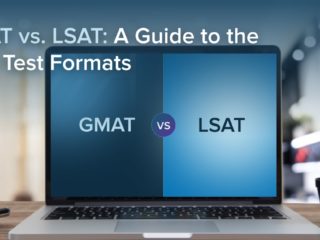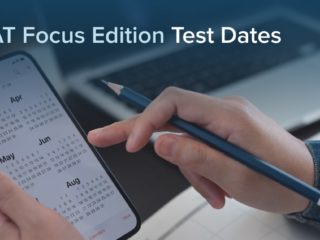| Getting your Trinity Audio player ready... |
Last Updated on April 1, 2025
If you’re considering taking the GMAT to apply to business schools, you may have heard that the GMAT is computer-adaptive. So, you may be wondering what a computer-adaptive test is and how the GMAT computer-adaptive test works. If so, you’ve come to the right place. In this article, I’ll cover how and why the GMAT is computer-adaptive and provide some tips for maximizing your GMAT score given the adaptive nature of the test.
Here are the topics we’ll cover:
- How Does the Computer-Adaptive Test Work?
- Why Is the GMAT Adaptive?
- How a Computer-Adaptive GMAT Affects Test-Takers
- Are GMAT Mocks Adaptive?
- How the GMAT Computer-Adaptive Test Works: Key Takeaways
- What’s Next?
Let’s begin by discussing the basics of computer-adaptive tests and how the GMAT computer-adaptive test works.
How Does the Computer-Adaptive Test Work?
A computer-adaptive test (CAT) adjusts to the performance of each test-taker. In other words, the difficulty of the test changes in accordance with how the test-taker is performing. The stronger the performance of the test-taker, the more difficult the test becomes. The weaker the performance of the test-taker, the easier the test becomes.
Computer-adaptive tests can work in different ways. The GMAT is computer-adaptive at the question level. So, the GMAT adapts by determining which questions to present on the basis of how test-takers are performing.
Put simply, if a GMAT test-taker answers a question correctly, the computer next presents a harder question. On the other hand, if the test-taker misses a question, the GMAT next presents an easier question.
To be clear, the difficulty level goes only so high or so low. It doesn’t keep increasing or decreasing endlessly. So, if you keep getting correct or missing GMAT questions, the difficulty level will eventually stabilize at a very high or very low level. However, most GMAT test-takers never reach the high or low extremes of the difficulty levels.
KEY FACT:
The GMAT is computer-adaptive at the question level.
The GMAT Computer-Adaptive Test in Action
To see the GMAT computer-adaptive test in action, take a look at the following graphs from the Quant portion of a GMAT Enhanced Score Report (ESR).
The above two graphs represent what occurred during the Quant section of a test-taker’s GMAT. Both graphs are divided into quarters of the Quant section, each of which includes a quarter of the Quant questions. The top graph shows the percentages of questions the test-taker got correct and incorrect in each quarter. The bottom graph shows the difficulty levels of the questions the test-taker was seeing.
The top graph shows that, in the first quarter of the Quant section, the test-taker got all the questions correct. Then, the bottom graph shows that the difficulty level of the questions increased in the first quarter. This increase in difficulty is the result of the test-taker’s getting the questions correct.
Then, the top graph shows that, in the second and third quarters, the test-taker got a few questions incorrect. The bottom graph shows that the difficulty level of the questions stabilized during that part of the test.
Finally, in the fourth quarter, the test-taker missed most of the questions. Looking at the bottom graph, we see the result of the test-taker’s missing those questions. The GMAT reduced the difficulty of the questions presented.
KEY FACT:
As a GMAT test-taker gets correct or misses questions, the GMAT algorithm increases or decreases the difficulty of the questions the test-taker sees.
Now that we understand the basics of how the GMAT CAT works, let’s discuss why the GMAT is computer-adaptive.
Why Is the GMAT Adaptive?
The GMAT is computer-adaptive so that it’s efficient, accurately assessing test-takers’ skills without using more time than necessary. In other words, by being computer-adaptive, the GMAT can avoid presenting test-takers with questions that won’t provide new information about their skills. Here’s why that’s the case.
For a non-adaptive test to be effective, it must include questions of a wide range of difficulties. Easier questions are needed for testing the skills of less skilled test-takers. Harder questions are needed for testing the skills of more skilled test-takers.
Thus, on a non-adaptive test that tests everyone’s skills effectively, less skilled test-takers will see many questions they can’t answer. On the same test, more skilled test-takers will see many questions they can easily answer. Presenting test-takers with many questions that they can’t answer or can easily answer doesn’t help to measure their skills. So, everyone’s time is wasted.
In contrast, by adapting, the GMAT presents each test-taker with questions that are more likely to fit the test-taker’s skill level, without also presenting many questions that are less likely to fit the test-taker’s skill level. Thus, by being adaptive, the GMAT works efficiently and saves everyone time.
KEY FACT:
The GMAT is adaptive to save time for test-takers and test providers.
Now that we understand basically how the GMAT’s computer-adaptive algorithm works and why the GMAT is computer-adaptive, let’s discuss how the fact that the GMAT is computer-adaptive affects test-takers.
How a Computer-Adaptive GMAT Affects Test-Takers
The fact that the GMAT is computer-adaptive affects test-takers in multiple ways. Let’s discuss each of them starting with the effect on the difficulty of the questions a test-taker sees.
The Questions Presented Tend to Be Challenging for the Test-Taker
As we have discussed, as you get GMAT questions correct, the computer presents more difficult questions. The result of the GMAT’s working in this way is that most test-takers end up seeing some questions that are too hard for them to answer. In other words, the difficulty of the questions on the GMAT keeps increasing until it’s too high for a test-taker of a particular skill level to handle.
Another effect is that even the GMAT questions a test-taker can answer will be relatively challenging for that test-taker. This outcome is logical given that the test increases the difficulty level of the questions until the test-taker misses questions. Yes, when the test-taker misses a question, the difficulty level of the next question may be a little lower. Still, it’s just below the difficulty level of a question the test-taker could not answer. So, the question will still be relatively challenging for the test-taker.
Thus, part of your GMAT success strategy should be preparing to guess on some questions. After all, if the GMAT increases the difficulty of the questions as we get questions correct, then there is a good chance that we’ll see some questions that we can’t answer in the time allotted. So, for the purposes of effective time-management, we’ll have to guess on those questions to leave ourselves sufficient time for questions we can answer.
TTP PRO TIP:
Because the GMAT may present some questions that you’re not ready to answer in the time allotted, preparing to guess on some questions should be part of your GMAT success strategy.
Test-Takers Get Only One Shot at Each GMAT Question
On the GMAT, we see just one question at a time and get one shot at each question. Unlike on some other standardized tests, we can’t return to questions we’ve already seen. The GMAT has to work this way because it needs our performance on previous questions to determine the difficulty of the current question. So, we must answer the questions on the GMAT in the order in which they appear.
KEY FACT:
Because of the way the GMAT CAT functions, we must answer GMAT questions in the order in which they’re presented.
The Same Number of Correct Answers Can Produce Different GMAT Scores
In the GMAT’s computer-adaptive scoring algorithm, questions of different difficulties have different values. Put simply, more difficult GMAT questions are worth more than easier questions. So, your GMAT score is based not only on the number of questions you answer correctly but also on the difficulty of the questions you answer correctly or miss.
As a result, the same number of correct answers in the Quant and Verbal sections can produce different GMAT scores. For example, 23 correct answers in the Quant section can produce a range of Quant scores, including Q48 or Q50. Similarly, with 23 correct answers in the Verbal section, you could get a variety of scores, including V34 or V42. What a wide range!
Considering just those possible scores on the Verbal and Quantitative sections, we see that, with a total of 46 correct answers, you could score from 660 to 750 on the GMAT. So, we can see that a certain number of correct answers can produce a wide range of GMAT scores.
The same number of correct answers in the Quant and Verbal sections can produce different GMAT scores.
You Need to Get Medium-Difficulty Questions Correct to Score High
To score high on the GMAT, you need to get medium-difficulty questions correct. Here’s why.
The GMAT’s computer-adaptive algorithm is such that, when you miss questions, you don’t just not score points. Instead, you drive your score lower because the GMAT takes your missing a question as indicating that you aren’t sufficiently skilled to get that question correct.
Now, if you miss a hard question, your score doesn’t decrease much. This outcome makes sense, since you can be highly skilled and still miss a hard question. On the other hand, if you miss a medium-difficulty question, your score takes a relatively significant hit. So, to keep your score from being dinged in this way, you need to get medium questions correct.
Also, to be presented with high-value hard questions, you need to get medium questions correct. In other words, you won’t even see hard questions unless you get a number of medium questions correct in a row.
So, in your GMAT practice, you need to make a point of learning to get medium-difficulty questions correct, so that you get them correct on test day. In fact, getting medium-difficulty questions correct is the foundation of a high GMAT score.
TTP PRO TIP:
To score high on the GMAT, learn to get medium questions correct consistently.
Speaking of test day, people generally use GMAT practice tests to prepare to handle the actual GMAT on test day. So, let’s discuss whether those tests are adaptive like the real GMAT.
Are GMAT Mocks Adaptive?
The short answer to the question of whether GMAT mocks, i.e., full-length practice tests, are adaptive is that most of them are. The official practice tests, often called “GMAT Prep” tests are adaptive, and most third-party GMAT practice tests are as well. So, we can learn to handle the computer-adaptive aspect of the GMAT by taking full-length practice tests under realistic conditions.
When you review GMAT computer-adaptive practice tests you’ve taken, you’ll notice that the difficulty of the questions increased as you got questions correct. You may also notice that getting questions correct in long streaks helped you to score high. In addition, you may see how different mixes of easy and hard questions resulted in different GMAT scores, even if you got the same number of questions correct.
TTP PRO TIP:
To learn to handle the computer-adaptive aspect of the GMAT, take full-length practice tests under realistic conditions.
How the GMAT Computer-Adaptive Test Works: Key Takeaways
Here is what we’ve learned about the GMAT computer-adaptive test (CAT):
- The GMAT is computer-adaptive at the question level, determining which questions to present on the basis of test-taker performance on the previous questions.
- The GMAT is computer-adaptive so that it assesses test-takers’ skills efficiently.
- Because the GMAT is computer-adaptive, the questions a test-taker sees tend to be challenging for that test-taker.
- In order for the GMAT CAT to have the information it needs to determine which questions to present, test-takers get only one shot at each GMAT question.
- Because of the way the GMAT CAT works, different numbers of correct answers can produce different scores.
- Because of the way the GMAT CAT works, test-takers need to get medium-level questions correct to score high.
- Test-takers can practice handling the computer-adaptive aspect of the GMAT by taking GMAT practice tests.
What’s Next?
Now that you know how the GMAT CAT works, you can learn about how to maximize your GMAT score from our posts on how to increase your GMAT Quant score and how to score high on GMAT Verbal.



